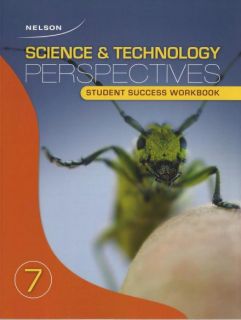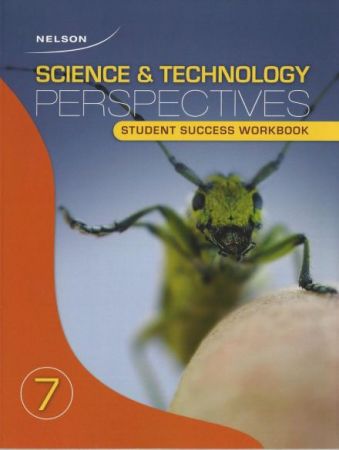Shop by Brand
More Information
.png)

Nelson Science & Technolgoy Perspectives 7 - Student Success Workbook
Model: 9780176325190The Nelson Science & Technolgoy Perspectives 7 - Student Success Workbook supports The Ontario Curriculum, Grades 7: Science and Technology, 2007
It has these units and chapters:
UNIT A: PURE SUBSTANCES AND MIXTURES
Chapter 1 CLASSIFYING MATTER
- What Is Matter?
- Puzzling over the Particle Theory
- More About Matter
- Changing States
- Pure Substances and Mixtures
- Identifying Pure Substances and Mixtures
- Mechanical Mixtures and Solutions
- Understanding Everyday Mixtures
Chapter 2 SOLUTIONS
- Solutes and Solvents
- Solving for Solutes and Solvents
- Dissolving and the Particle Theory
- Soluble and Insoluble Solutes
- Concentration and Solubility
- Calculating Solubility
Chapter 3 SEPARATING MIXTURES
- Separating Mechanical Mixtures
- Mix It Up!
- Protecting the Environment by Separating Mixtures
- Go with the Flow
- Separating Solutions
- Defending Your Choice
- Mixtures in Industry
- Solve the Riddle
UNIT B: INTERACTIONS IN THE ENVIRONMENT
Chapter 4 HEALTHY ECOSYSTEMS
- What Is an Ecosystem?
- Analyze Parts of an Ecosystem
- The Needs of Living Things
- Identify the Basic Needs of Living Things
- Interactions among Living Things
- Analyze Changes in Populations
- How Do Humans Fit into Ecosystems?
- Think Green
Chapter 5 INTERACTIONS WITHIN ECOSYSTEMS
- The Roles of Organisms in an Ecosystem
- Complete a Table: Roles in an Ecosystem
- Food Chains and Food Webs
- Analyze a Food Chain
- Energy Flow in an Ecosystem
- Explore Energy in Food Chains
- Matter Cycles
- Analyze Cycles in Earth 's Ecosystems
Chapter 6 ORGANISMS DEPEND ON A HEALTHY ENVIRONMEN
- The Dynamics of Nsature: Succession
- Order the Stages of Succession
- Human Impact on Ecosystems
- Connect Human Actions with Biodiversity
- Protecting the Environment
- Identify Examples of Stewardship
- Traditional Knowledge and Stewardship of Earth
- Identify Traditional Knowledge
UNIT C: HEAT IN THE ENVIRONMENT
Chapter 7 HEATING AND COOLING
- Warmth and Coldness
- Illustrating Warmth and Coldness
- Explaining Hot and Cold
- Describing the Transfer of Energy
- Kinetic Energy, Heat, and Temperature
- What is Puzzling about Kinetic Energy, Heat, and Temperature?
- A State of Matter State of Mind
- Living with Thermal Expansion and Contraction
- Understanding Thermal Expansion and Contraction
Chapter 8 ENERGY TRANSFER AND CONSERVATION
- Thermal Energy Transfer
- Reviewing Energy Transfer
- Conduction
- Packing a Lunch
- Conduction and Geological Processes
- Reviewing Geological Processes
- Convection
- Moving Along with Convection
- Convection in the Environment
- Connecting to Convection in the Environment
- Radiation
- Puzzling over Radiation
- Managing the Transfer of Thermal Energy
- Investigating Home Energy Loss
Chapter 9 HEAT SOURCES IN THE ENVIRONMENT
- Energy Sources
- Investigating Energy
- Conventional Energy Sources
- Analyzing Energy Sources
- Global Warming
- Global Warming Workout
- Alternative Energy Sources: Wind and Wave Energy
- Riding the Wind and Waves
- Alternative Energy Sources: Solar Energy
- Working with Solar Energy
- Alternative Energy Sources: Geothermal Energy
- Pump It Up!
- Alternative Energy Sources: Biofuels
- A Biofuels Brain Puzzler
UNIT D: FORM AND FUNCTION
Chapter 10 STRUCTURES IN THE WORLD
- Structures All Around Us
- Explore Structures
- Forces
- Classifying Forces
- Classifying Structures
- Complete a Table: Structural Forms
- External and Internal Forces
- Identify Examples of Internal and External Forces
Chapter 11 STRUCTURAL STRENGTH AND STABILITY
- Stability of Structures
- Explain Centre of Gravity and Stability
- Making Structures Strong: The Beam
- Find Structural Support Solutions
- Making Structures Strong: The Truss, Arch, and Dome
- Identifying Trusses, Arches, and Domes in Arctitecture
- Structural Failure
- Analyze Structural Failure
Chapter 12 FORM, FUNCTION, AND BEAUTY
- The Product Development Process
- Design Your Own Product
- Symmetry in Form and Function
- Symmetrical or Asymmetrical?
- Ergonomics: Designing for Human Comfort and Safety
- Evaluate Tools for Ergonomic Design
- Universal Design
- Applying Universal Design Principles
280 pages.




